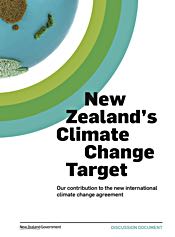 Sarah Thomson, the Waikato law student who made news last month when she announced her intention to sue the New Zealand government for its weak climate targets, has launched a crowd-funding campaign to help cover the costs of a judicial review. The Give A Little campaign, created by former Hamilton City councillor Daphne Bell, launched today. At the time of writing it has already raised over $1,000.
Sarah Thomson, the Waikato law student who made news last month when she announced her intention to sue the New Zealand government for its weak climate targets, has launched a crowd-funding campaign to help cover the costs of a judicial review. The Give A Little campaign, created by former Hamilton City councillor Daphne Bell, launched today. At the time of writing it has already raised over $1,000.
Mrs Bell explained why she supports Sarah’s initiative:
The Give A Little page will enable the many people around the country who support her an easy and practical way to help. They include those who cheered her speeches at the climate change marches in Auckland and Hamilton, and many more around New Zealand who applaud her ground-breaking legal action.
At the Auckland climate march last month, Sarah said:
“It is young people who will pay the true cost of today’s inaction. Our government has a duty to its people, to ensure a safe place for us and our children to live. But, if they are not fulfilling that duty, it is up to us to demand action.”
Although Sarah’s lawyers are donating their time, money is still needed for the filing fee at the High Court, other legal costs and disbursements and associated costs for Sarah relating to her court action — which will be heard in Wellington. Expert witnesses already lined up to give evidence include Jim Hansen and professor Jim Renwick of VUW.
Any money not used will be kept in a solicitor’s trust account and disbursed to a registered environmental charity or charities.
If you have a few dollars to spare, why not Give A Little in a good cause? At the very least, Sarah’s action will remind John Key and new climate minister Paula Bennett that they owe a duty of care to everyone in New Zealand, not just their fossil fool friends.
 What can I add to the millions of words in dozens of languages that have already been written by the thousands of journalists and commentators around the Paris Agreement? We now have a globally binding agreement that really looks like it could curtail the use of a fuel that has been central to our way of life for more than 150 years.
What can I add to the millions of words in dozens of languages that have already been written by the thousands of journalists and commentators around the Paris Agreement? We now have a globally binding agreement that really looks like it could curtail the use of a fuel that has been central to our way of life for more than 150 years.
 I’ve been in Paris for over a week now, and the speed at which everything goes past, including time, is frightening. I think the 40,000 expected have now all arrived. I’m getting worried the only Eiffel Tower I’ll see is the one made of red folding chairs at the end of the “Champs Elysee” at the meeting.
I’ve been in Paris for over a week now, and the speed at which everything goes past, including time, is frightening. I think the 40,000 expected have now all arrived. I’m getting worried the only Eiffel Tower I’ll see is the one made of red folding chairs at the end of the “Champs Elysee” at the meeting. Sarah Thomson, the Waikato law student who
Sarah Thomson, the Waikato law student who  At the end of last week, with the deadline
At the end of last week, with the deadline Today’s news that the US and China have agreed a long term policy to reduce carbon emissions is
Today’s news that the US and China have agreed a long term policy to reduce carbon emissions is